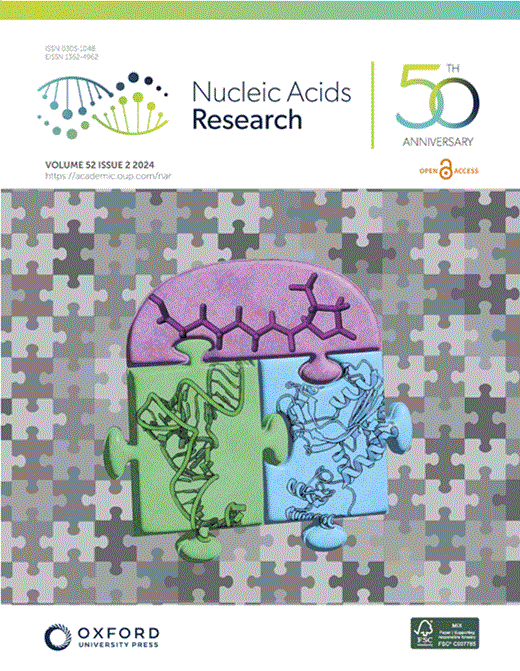通过碱基修饰和质谱分析揭示了鸟嘌呤碱基与RNA阴离子中磷酸二酯基团相互作用的内在偏好。
IF 16.6
2区 生物学
Q1 BIOCHEMISTRY & MOLECULAR BIOLOGY
引用次数: 0
摘要
核糖核酸(rna)在碱性水溶液中自发的骨干断裂倾向于鸟苷的5′侧。这种现象也可以在完全脱溶的RNA (M - nH)n离子受到低能碰撞激活解离的振动激活时观察到。然而,裂解反应的化学机制至今仍不清楚。通过对具有位点特异性脱氮修饰(c1G, c3G, c7G)或甲基修饰(m2G, m22G)的RNA和鸟苷为肌苷取代的RNA进行比较研究,我们发现优先切割是由于鸟苷碱基与5'侧磷酸二酯部分的非桥接氧的双齿相互作用。参与鸟苷5'侧RNA裂解反应的单分子化学可能有助于理解自裂解核酶催化策略的进化。本文章由计算机程序翻译,如有差异,请以英文原文为准。
The intrinsic preference of guanosine bases for cleavage-facilitating interactions with phosphodiester moieties in RNA anions revealed by base modifications and mass spectrometry.
Spontaneous backbone cleavage of ribonucleic acids (RNAs) in basic aqueous solution has a preference for the 5' side of guanosine. This phenomenon can also be observed in fully desolvated RNA (M - nH)n- ions subjected to vibrational activation by low-energy collisionally activated dissociation. However, the underlying chemical mechanism of the cleavage reaction has so far remained elusive. Using RNA with site-specific deaza (c1G, c3G, c7G) or methyl (m2G, m22G) modifications and RNA with guanosine to inosine substitution in a comparative study, we show here that preferential cleavage is due to bidentate interactions of guanosine bases with the nonbridging oxygens of phosphodiester moieties on their 5' side. The unimolecular chemistry involved in the RNA cleavage reaction on the 5' side of guanosine may help to understand the evolution of catalytic strategies employed by self-cleaving ribozymes.
求助全文
通过发布文献求助,成功后即可免费获取论文全文。
去求助
来源期刊

Nucleic Acids Research
生物-生化与分子生物学
CiteScore
27.10
自引率
4.70%
发文量
1057
审稿时长
2 months
期刊介绍:
Nucleic Acids Research (NAR) is a scientific journal that publishes research on various aspects of nucleic acids and proteins involved in nucleic acid metabolism and interactions. It covers areas such as chemistry and synthetic biology, computational biology, gene regulation, chromatin and epigenetics, genome integrity, repair and replication, genomics, molecular biology, nucleic acid enzymes, RNA, and structural biology. The journal also includes a Survey and Summary section for brief reviews. Additionally, each year, the first issue is dedicated to biological databases, and an issue in July focuses on web-based software resources for the biological community. Nucleic Acids Research is indexed by several services including Abstracts on Hygiene and Communicable Diseases, Animal Breeding Abstracts, Agricultural Engineering Abstracts, Agbiotech News and Information, BIOSIS Previews, CAB Abstracts, and EMBASE.
 求助内容:
求助内容: 应助结果提醒方式:
应助结果提醒方式:


